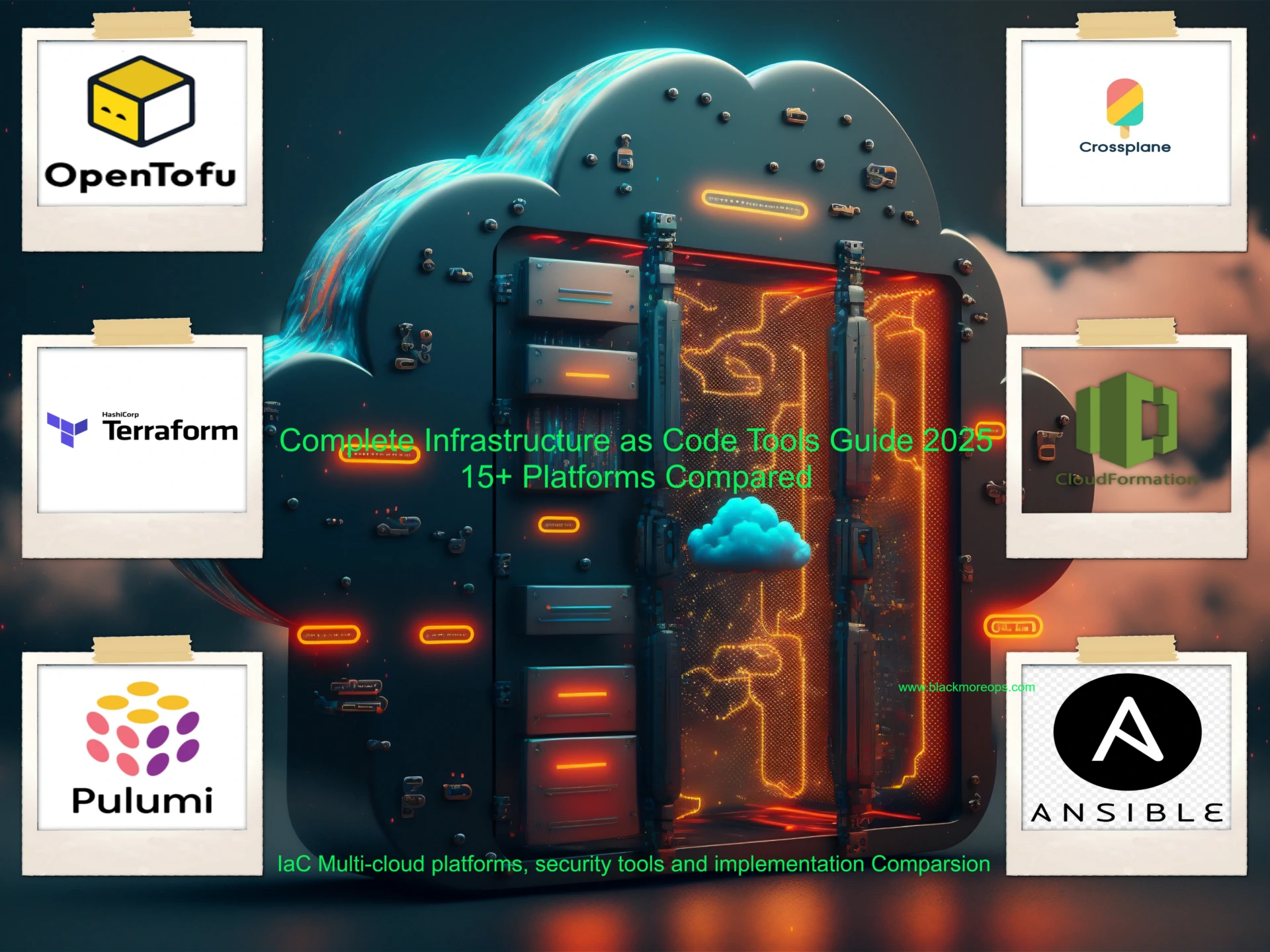Infrastructure as Code tools have revolutionised modern infrastructure management, transforming manual processes into automated, scalable deployments. The Infrastructure as Code market is projected to reach USD 3.3 billion in 2025, driven by widespread cloud adoption and DevOps practices. This comprehensive guide examines the leading Infrastructure as Code platforms, helping organisations choose optimal tools for their infrastructure automation needs.
Whether you’re implementing Infrastructure as Code tools for the first time or evaluating alternatives to existing solutions, this detailed analysis provides the foundation for informed decision-making across multi-cloud environments, configuration management, and security integration. For comprehensive evaluation frameworks and decision matrices, our Infrastructure as Code tool selection guide offers detailed methodologies for choosing optimal platforms.

Comprehensive Infrastructure as Code tools landscape for 2025 featuring multi-cloud and automation platforms
Table of Contents
Understanding Infrastructure as Code in 2025
Infrastructure automation eliminates manual configuration processes, enabling teams to define, deploy, and manage infrastructure through code. Modern Infrastructure as Code tools support declarative configurations, version control integration, and multi-cloud deployments, making them essential for scalable infrastructure management.
The Infrastructure as Code approach provides numerous benefits including consistency, repeatability, version control, and cost optimisation. Teams can treat infrastructure changes like software development, applying code review processes, testing methodologies, and continuous integration practices to infrastructure management.
Key Benefits of Infrastructure as Code
Infrastructure automation reduces deployment time from hours to minutes, eliminates configuration drift, and ensures consistent environments across development, staging, and production. Teams gain visibility into infrastructure changes through version control, enabling rapid rollback and disaster recovery capabilities.
Cost optimisation occurs through automated resource lifecycle management, preventing resource sprawl and enabling dynamic scaling based on demand. Security improvements result from codified security policies and automated compliance scanning throughout the deployment pipeline.
Infrastructure as Code Tools Categories
Modern Infrastructure as Code tools fall into several distinct categories, each addressing specific infrastructure management requirements:
Multi-Cloud Infrastructure Platforms
Multi-cloud Infrastructure as Code tools enable consistent resource provisioning across AWS, Azure, Google Cloud, and other providers. These platforms provide vendor independence whilst maintaining unified infrastructure management approaches.
Leading Multi-Cloud Tools:
- Terraform: Industry standard with extensive provider ecosystem
- OpenTofu: Open source Terraform alternative with community governance
- Pulumi: Programming language-first approach for complex infrastructure logic
- Crossplane: Kubernetes-native infrastructure management
Configuration Management and Automation
Configuration management tools focus on server configuration, application deployment, and ongoing maintenance tasks. These Infrastructure as Code tools excel at ensuring consistent system states across distributed environments.
Leading Configuration Tools:
- Ansible: Agentless automation with YAML playbooks
- Puppet: Enterprise configuration management with powerful abstractions
- Chef: Ruby-based infrastructure automation
- SaltStack: Event-driven automation with high performance
Cloud-Specific Infrastructure Platforms
Cloud-specific Infrastructure as Code tools provide deep integration with individual cloud providers, offering native service support and advanced features unavailable in multi-cloud platforms.
Leading Cloud-Specific Tools:
- AWS CloudFormation: Native AWS infrastructure management
- Azure Resource Manager (ARM): Azure-native infrastructure provisioning
- AWS CDK: Programming approach for AWS infrastructure
- Azure Bicep: Simplified Azure domain-specific language
Container and Kubernetes Infrastructure
Container infrastructure tools focus on orchestrating containerised applications and managing cluster resources. These Infrastructure as Code tools are essential for modern application deployment strategies.
Leading Container Platforms:
- Kubernetes: Industry standard container orchestration
- Docker Swarm: Simple container clustering
- Red Hat OpenShift: Enterprise Kubernetes platform
- Rancher: Multi-cluster Kubernetes management
When evaluating container orchestration options, understanding the key differences between Kubernetes vs Docker Swarm helps teams choose the most appropriate platform for their infrastructure automation needs.
Security and Compliance Tools
Security-focused Infrastructure as Code tools scan infrastructure definitions for vulnerabilities and compliance violations, enabling shift-left security practices within development workflows.
Leading Security Tools:
- Checkov: Static code analysis for Infrastructure as Code
- Terrascan: Policy-as-code security enforcement
- Snyk: Developer-first security scanning
- Bridgecrew: Cloud security posture management
Top 10 Infrastructure as Code Tools Quick Comparison
| Tool | Type | Licence | Multi-Cloud | Learning Curve | Best For |
|---|---|---|---|---|---|
| Terraform | Multi-Cloud IaC | BSL | ✅ Excellent | Moderate | Enterprise multi-cloud |
| OpenTofu | Multi-Cloud IaC | MPL 2.0 | ✅ Excellent | Moderate | Open source alternative |
| Pulumi | Programming IaC | Apache 2.0 | ✅ Excellent | Moderate-High | Developer-centric teams |
| Ansible | Config Management | GPL v3 | ✅ Good | Easy | Configuration automation |
| Kubernetes | Container Platform | Apache 2.0 | ✅ Excellent | High | Container orchestration |
| AWS CloudFormation | Cloud-Specific | AWS Service | ❌ AWS Only | Moderate | AWS-native deployments |
| Puppet | Config Management | Apache 2.0 | ✅ Good | High | Enterprise config management |
| Crossplane | K8s-Native IaC | Apache 2.0 | ✅ Good | High | Kubernetes-centric orgs |
| Chef | Config Management | Apache 2.0 | ✅ Good | High | Ruby-based automation |
| Checkov | Security Scanning | Apache 2.0 | ✅ Excellent | Easy | IaC security scanning |
Infrastructure as Code Tool Selection Framework
Choosing the right Infrastructure as Code tools requires evaluating multiple factors including team expertise, infrastructure requirements, security needs, and long-term strategic goals. Similar to how organisations approach OSINT tool selection for cybersecurity intelligence, Infrastructure as Code platform evaluation benefits from systematic frameworks that assess technical capabilities against organisational requirements.
For Small Teams (1-50 Servers)
Small teams benefit from Infrastructure as Code tools with gentle learning curves and minimal operational overhead. Focus on tools providing immediate value without extensive training requirements.
Recommended Approach:
- Multi-Cloud: OpenTofu for free, community-driven infrastructure provisioning
- Configuration: Ansible for simple, agentless automation
- Containers: Docker Swarm for easy container clustering
- Security: Checkov for free, comprehensive security scanning
Small teams managing Linux-based infrastructure should also consider implementing effective remote administration tools to maintain consistent server management capabilities alongside Infrastructure as Code automation.
For Medium Organisations (50-500 Servers)
Medium-sized organisations require Infrastructure as Code tools balancing functionality with manageable complexity. These tools should support team collaboration whilst providing room for growth.
Recommended Approach:
- Multi-Cloud: Terraform with Terraform Cloud for team collaboration
- Configuration: Ansible with Tower/AWX for centralised management
- Containers: Kubernetes for industry-standard orchestration
- Security: Checkov + Terrascan for comprehensive coverage
Medium organisations should implement comprehensive monitoring strategies that complement their Infrastructure as Code deployments. Linux monitoring tools provide essential visibility into infrastructure performance and help teams identify optimisation opportunities across their automated infrastructure.
For Enterprise (500+ Servers)
Enterprise environments require comprehensive Infrastructure as Code platforms with advanced features, enterprise support, and sophisticated governance capabilities.
Recommended Approach:
- Multi-Cloud: Terraform Enterprise for advanced collaboration and governance
- Configuration: Puppet Enterprise for compliance reporting and analytics
- Containers: Red Hat OpenShift for enterprise Kubernetes with support
- Security: Snyk + custom policies for comprehensive security scanning
Multi-Cloud Infrastructure Strategies
Modern organisations increasingly adopt multi-cloud strategies to avoid vendor lock-in, optimise costs, and leverage best-of-breed services. Infrastructure as Code tools enable consistent management across multiple cloud providers whilst maintaining portability and flexibility.
Multi-Cloud Benefits:
- Vendor Independence: Avoid single-cloud dependency
- Risk Mitigation: Reduce single points of failure
- Cost Optimisation: Leverage competitive pricing across providers
- Service Selection: Choose optimal services from each provider
Implementation Approach:
- Choose cloud-agnostic Infrastructure as Code tools (Terraform, OpenTofu, Pulumi)
- Implement consistent configuration management across all clouds
- Use Kubernetes for portable container workloads
- Design abstraction layers to hide cloud-specific implementations
Security Integration Best Practices
Modern Infrastructure as Code workflows must integrate security scanning and compliance checking throughout the development lifecycle. This shift-left approach enables teams to identify and fix security issues before deployment.
DevSecOps Integration:
- Pre-Commit Hooks: Local security scanning with Checkov
- CI/CD Pipelines: Automated policy enforcement with Terrascan
- Runtime Monitoring: Continuous compliance checking and drift detection
- Policy as Code: Version-controlled security policies alongside infrastructure
Future Infrastructure as Code Trends
The Infrastructure as Code landscape continues evolving with artificial intelligence integration, platform engineering practices, and edge computing requirements driving innovation.
Emerging Trends:
- AI Enhancement: Intelligent resource optimisation and automated troubleshooting
- Platform Engineering: Self-service infrastructure with governance controls
- Edge Computing: Distributed infrastructure management capabilities
- GitOps Evolution: Advanced continuous deployment workflows
Getting Started with Infrastructure as Code
Begin your Infrastructure as Code journey with foundational tools that provide immediate value whilst building expertise for advanced implementations:
- Start Simple: Begin with OpenTofu for infrastructure provisioning and Ansible for configuration management
- Build Expertise: Gradually implement security scanning with Checkov
- Scale Gradually: Add container orchestration with Kubernetes as requirements grow
- Enhance Security: Integrate comprehensive security scanning and policy enforcement
- Consider Enterprise Features: Evaluate commercial platforms as organisation scales
Conclusion
Infrastructure as Code tools offer unprecedented opportunities for organisations to build resilient, scalable, and secure infrastructure through automation. From multi-cloud platforms like Terraform and OpenTofu to specialised security tools like Checkov and Terrascan, modern teams have access to comprehensive toolsets for infrastructure management.
Success with Infrastructure as Code depends on choosing tools that align with team capabilities, organisational requirements, and long-term strategic goals. The platforms examined in this guide provide solid foundations for infrastructure automation, enabling teams to implement practices that scale with business requirements whilst maintaining security, compliance, and operational excellence.
Infrastructure as Code represents a fundamental shift toward treating infrastructure with the same discipline and practices applied to application development. Start with the tools outlined in this comprehensive guide, then expand your capabilities as expertise and requirements grow.
Discover more from blackMORE Ops
Subscribe to get the latest posts sent to your email.

